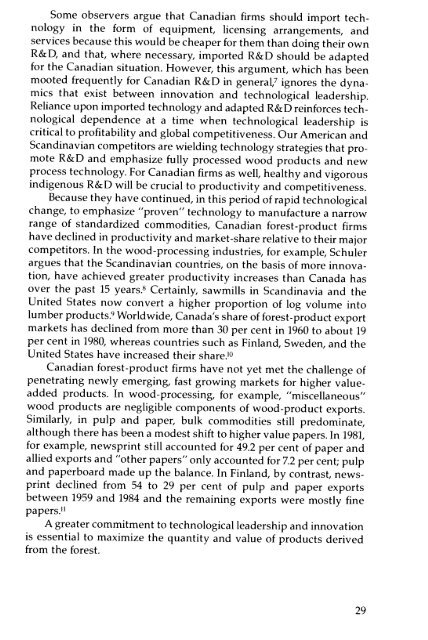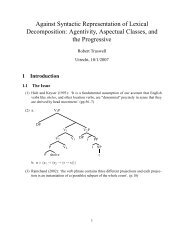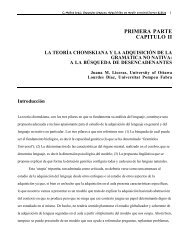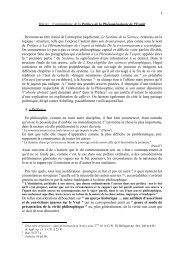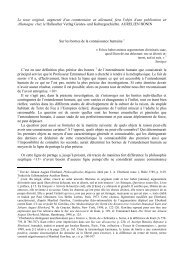Technology and the Canadian Forest-Product Industries ... - ArtSites
Technology and the Canadian Forest-Product Industries ... - ArtSites
Technology and the Canadian Forest-Product Industries ... - ArtSites
You also want an ePaper? Increase the reach of your titles
YUMPU automatically turns print PDFs into web optimized ePapers that Google loves.
Some observers argue that <strong>Canadian</strong> firms should import technologyin <strong>the</strong> form of equipment, licensing arrangements, <strong>and</strong>services because this would be cheaper for <strong>the</strong>m than doing <strong>the</strong>ir ownR& 0, <strong>and</strong> that, where necessary, imported R&0 should be adaptedfor <strong>the</strong> <strong>Canadian</strong> situation. However, this argument, which has beenmooted frequently for <strong>Canadian</strong> R&D in general," ignores <strong>the</strong> dynamicsthat exist between innovation <strong>and</strong> technological leadership.Reliance upon imported technology <strong>and</strong> adapted R&D reinforces technologicaldependence at a time when technological leadership iscritical to profitability <strong>and</strong> global competitiveness. Our American <strong>and</strong>Sc<strong>and</strong>inavian competitors are wielding technology strategies that promoteR&D <strong>and</strong> emphasize fully processed wood products <strong>and</strong> newprocess technology. For <strong>Canadian</strong> firms as well, healthy <strong>and</strong> vigorousindigenous R&D will be crucial to productivity <strong>and</strong> competitiveness.Because <strong>the</strong>y have continued, in this period of rapid technologicalchange, to emphasize "proven" technology to manufacture a narrowrange of st<strong>and</strong>ardized commodities, <strong>Canadian</strong> forest-product firmshave declined in productivity <strong>and</strong> market-share relative to <strong>the</strong>ir majorcompetitors. In <strong>the</strong> wood-processing industries, for example, Schulerargues that <strong>the</strong> Sc<strong>and</strong>inavian countries, on <strong>the</strong> basis of more innovation,have achieved greater productivity increases than Canada hasover <strong>the</strong> past 15 years," Certainly, sawmills in Sc<strong>and</strong>inavia <strong>and</strong> <strong>the</strong>United States now convert a higher proportion of log volume intolumber products," Worldwide, Canada's share of forest-product exportmarkets has declined from more than 30 per cent in 1960 to about 19per cent in 1980, whereas countries such as Finl<strong>and</strong>, Sweden, <strong>and</strong> <strong>the</strong>United States have increased <strong>the</strong>ir share.w<strong>Canadian</strong> forest-product firms have not yet met <strong>the</strong> challenge ofpenetrating newly emerging, fast growing markets for higher valueaddedproducts. In wood-processing, for example, "miscellaneous"wood products are negligible components of wood-product exports.Similarly, in pulp <strong>and</strong> paper, bulk commodities still predominate,although <strong>the</strong>re has been a modest shift to higher value papers. In 1981,for example, newsprint still accounted for 49.2 per cent of paper <strong>and</strong>allied exports <strong>and</strong> "o<strong>the</strong>r papers" only accounted for 7.2 per cent; pulp<strong>and</strong> paperboard made up <strong>the</strong> balance. In Finl<strong>and</strong>, by contrast, newsprintdeclined from 54 to 29 per cent of pulp <strong>and</strong> paper exportsbetween 1959 <strong>and</strong> 1984 <strong>and</strong> <strong>the</strong> remaining exports were mostly finepapers,"A greater commitment to technological leadership <strong>and</strong> innovationis essential to maximize <strong>the</strong> quantity <strong>and</strong> value of products derivedfrom <strong>the</strong> forest.29


